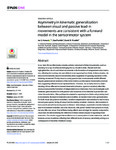Asymmetry in kinematic generalization between visual and passive lead-in movements are consistent with a forward model in the sensorimotor system
| dc.contributor.author | Howard, Ian | |
| dc.contributor.author | Franklin, S | |
| dc.contributor.author | Franklin, DW | |
| dc.date.accessioned | 2020-02-03T22:51:09Z | |
| dc.date.available | 2020-02-03T22:51:09Z | |
| dc.date.issued | 2020-01-29 | |
| dc.identifier.issn | 1932-6203 | |
| dc.identifier.issn | 1932-6203 | |
| dc.identifier.other | ARTN e0228083 | |
| dc.identifier.uri | http://hdl.handle.net/10026.1/15355 | |
| dc.description.abstract |
In our daily life we often make complex actions comprised of linked movements, such as reaching for a cup of coffee and bringing it to our mouth to drink. Recent work has highlighted the role of such linked movements in the formation of independent motor memories, affecting the learning rate and ability to learn opposing force fields. In these studies, distinct prior movements (lead-in movements) allow adaptation of opposing dynamics on the following movement. Purely visual or purely passive lead-in movements exhibit different angular generalization functions of this motor memory as the lead-in movements are modified, suggesting different neural representations. However, we currently have no understanding of how different movement kinematics (distance, speed or duration) affect this recall process and the formation of independent motor memories. Here we investigate such kinematic generalization for both passive and visual lead-in movements to probe their individual characteristics. After participants adapted to opposing force fields using training lead-in movements, the lead-in kinematics were modified on random trials to test generalization. For both visual and passive modalities, recalled compensation was sensitive to lead-in duration and peak speed, falling off away from the training condition. However, little reduction in force was found with increasing lead-in distance. Interestingly, asymmetric transfer between lead-in movement modalities was also observed, with partial transfer from passive to visual, but very little vice versa. Overall these tuning effects were stronger for passive compared to visual lead-ins demonstrating the difference in these sensory inputs in regulating motor memories. Our results suggest these effects are a consequence of state estimation, with differences across modalities reflecting their different levels of sensory uncertainty arising as a consequence of dissimilar feedback delays. | |
| dc.format.extent | e0228083-e0228083 | |
| dc.format.medium | Electronic-eCollection | |
| dc.language | en | |
| dc.language.iso | en | |
| dc.publisher | Public Library of Science (PLoS) | |
| dc.subject | Adaptation, Physiological | |
| dc.subject | Adult | |
| dc.subject | Biomechanical Phenomena | |
| dc.subject | Feedback, Sensory | |
| dc.subject | Female | |
| dc.subject | Generalization, Psychological | |
| dc.subject | Humans | |
| dc.subject | Male | |
| dc.subject | Models, Theoretical | |
| dc.subject | Movement | |
| dc.subject | Visual Perception | |
| dc.title | Asymmetry in kinematic generalization between visual and passive lead-in movements are consistent with a forward model in the sensorimotor system | |
| dc.type | journal-article | |
| dc.type | Journal Article | |
| dc.type | Research Support, Non-U.S. Gov't | |
| plymouth.author-url | https://www.webofscience.com/api/gateway?GWVersion=2&SrcApp=PARTNER_APP&SrcAuth=LinksAMR&KeyUT=WOS:000534609400042&DestLinkType=FullRecord&DestApp=ALL_WOS&UsrCustomerID=11bb513d99f797142bcfeffcc58ea008 | |
| plymouth.issue | 1 | |
| plymouth.volume | 15 | |
| plymouth.publication-status | Published online | |
| plymouth.journal | PLOS ONE | |
| dc.identifier.doi | 10.1371/journal.pone.0228083 | |
| plymouth.organisational-group | /Plymouth | |
| plymouth.organisational-group | /Plymouth/Faculty of Science and Engineering | |
| plymouth.organisational-group | /Plymouth/Faculty of Science and Engineering/School of Engineering, Computing and Mathematics | |
| plymouth.organisational-group | /Plymouth/REF 2021 Researchers by UoA | |
| plymouth.organisational-group | /Plymouth/REF 2021 Researchers by UoA/UoA11 Computer Science and Informatics | |
| plymouth.organisational-group | /Plymouth/Users by role | |
| plymouth.organisational-group | /Plymouth/Users by role/Academics | |
| dc.publisher.place | United States | |
| dcterms.dateAccepted | 2020-01-07 | |
| dc.rights.embargodate | 2020-2-5 | |
| dc.identifier.eissn | 1932-6203 | |
| dc.rights.embargoperiod | Not known | |
| rioxxterms.versionofrecord | 10.1371/journal.pone.0228083 | |
| rioxxterms.licenseref.uri | http://www.rioxx.net/licenses/all-rights-reserved | |
| rioxxterms.type | Journal Article/Review |


